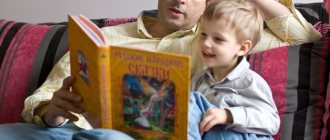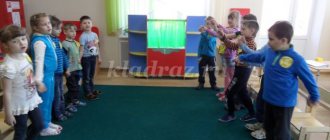Project "Fairy Tales"
Project theme: “RUSSIAN FOLK TALES”
Authors of the project: 5th grade students of the MBOU “Tat-Kitninskaya secondary school”
Target:
Get acquainted with Russian folk tales, instill love and interest in Russian folk art.
Objectives: 1.
to develop knowledge about Russian folk tales.
2.
cultivate interest in Russian folk art.
3.
instill a love for books. 4. compose your own fairy tale
Hypothesis:
answer the question what does the fairy tale teach?
Research methods:
1. Reading and studying Russian folk tales;
2. Watching cartoons and fairy tales;
3. Drawing fairy tale heroes.
Relevance
of this study is that: - A fairy tale is a beautiful creation of art. — A Russian folk tale is a work of oral creativity of the Russian people, one of the types of folklore prose — A Russian folk tale is a soil that has unlimited developmental and educational possibilities. It introduces children to the circle of extraordinary events and transformations that occur with their heroes, teaches them to be kind to people, and shows high feelings and aspirations. — A fairy tale for a child is nothing more than a special means of comprehending life, a way of knowing, comprehending certain life phenomena, the moral attitudes of society, and comprehending reality. The imagery of the fairy tale is well absorbed by the child. — Russian fairy tales always tell about something impossible in real life, but fantastic fiction contains an idea, that is, in fiction there is also a truth of life, which is expressed more strongly than if the story were told without fiction. Fairy tales of different nations are similar to each other. But every nation has special fairy tales. All Russian fairy tales bear the stamp of ancient life, customs, and orders.
Story:
The creation of fairy tales has an ancient history. Fairy tales appeared in such ancient times that it is very difficult to accurately determine the time of their birth. We also know little about the authors. Most likely, the fairy tales were composed by the same peasants and shepherds who often acted as the main characters of the story.
They passed on fairy tales from mouth to mouth, from generation to generation, changing and adding new details along the way. Tales were told by adults and - contrary to our understanding - not only to children, but also to adults. Fairy tales taught us how to get out of difficult situations, overcome trials with honor, conquer fear - and every fairy tale ended with a happy ending. Some scientists believe that the origins of fairy tales lie in primitive rituals. The rituals themselves were forgotten, but the stories were preserved as treasures of useful and instructive knowledge.
Main part:
Russian folk tales teach goodness, good always triumphs over evil, but the path to victory can be too long. Fairy tales give the child the first idea of such concepts as good and evil, wisdom and deceit, forgiveness, compassion. If you believe in yourself and don’t deviate from your principles, everything will work out. Children perceive everything, and even if they don’t realize the morality that the text contains, they at least try to be like the kind, sympathetic and resourceful heroes. Russian folk tales introduce the child to the vast universe in which he will have to live, with its physical laws, wildlife, history and culture. So Russian folk tales are not as simple as they might seem at first glance. They teach us a lot, so even adults should read fairy tales. The fairy tale is close to the child’s worldview, because he has an emotional and sensory perception of the world. He still does not understand the logic of adult reasoning. But the fairy tale does not teach directly. It contains only magical images that the child enjoys while determining his sympathies. In a fairy tale there is a clear boundary: this is Good, and this is Evil, this character is bad, and this one is good. And the baby knows that Koschey will definitely be defeated and good will win. This puts the child’s complex feelings in order, and a happy ending allows him to believe that in the future he will do something good.
A fairy tale is a special type of oral folk art. They came to us from the distant past. This is how our ancestors expressed their attitude to reality, to the world around them, and tried to explain the main laws of life. Reality changed, fairy tales changed, but the main meaning always remained: unbridled faith in goodness, in the strength of spirit, in love. Conventionally, Russian folk tales are divided into three groups: everyday tales, tales about animals and fairy tales. And each has its own characteristics. Households, for example, teach that happiness is not measured in money. And real happiness is family, work, love. It is no coincidence that a poor peasant is always smarter and happier than a rich master.
There are many sad and funny fairy tales in the world, we can’t live without light, we can’t live without them. May the heroes of fairy tales give us warmth, may good triumph over evil forever!
Conclusions:
As you know, it is from these simple, funny and sometimes magical stories that a child begins his journey of understanding the world. A child can easily transfer images and plots created in fairy tales to his own life and apply them when the opportunity arises. One of the functions of a fairy tale is to form values for the little ones. After all, it is fairy-tale heroes who later become guides to life; it is from fairy tales in a playful presentation that a child receives accurate knowledge of what good and evil, joy and sorrow, cowardice and heroism are. Many of the images that a child gets used to in a fairy tale can last a lifetime. Listening to fairy tales, we deeply sympathize with the characters and experience the events described, try on the best traits of people, learn good and evil, cowardice and courage, show sympathy and compassion, are charged with positive energy, gain knowledge about the world and learn to live. By telling and reading fairy tales, we develop our inner world, gain knowledge about the laws of life and ways to demonstrate creative ingenuity. Reading a fairy tale forms the foundations of behavior and communication for life, teaches perseverance, patience, and the ability to set goals and go towards them. Children's fairy tales are a necessary element of education; they tell us about life in an accessible language, teach us, highlight the problems of good and evil, and show the way out of difficult situations.
Fairy tales written by 5th grade students
Once upon a time there was a girl. Her name was Elena. When she was very young, her parents abandoned her. The girl knew how to do magic.
One day Elena went into the forest to pick berries. I picked up a full basket of berries and went home. The next day she went into the forest again. But she saw red apples on the apple tree and collected a whole basket.
On the third day I went to pick raspberries. And suddenly he hears someone crying in the bushes. Elena looked and saw an old grandmother. The girl asks: “Why are you crying?”
“You see,” the old woman answers, “when I was young, I was very beautiful, but now I have turned into an ugly old woman. I don't look like myself. But I want to always be young and beautiful.”
“Don’t cry,” says Elena, “I’ll make you young and beautiful in an instant.”
Grandma believed Elena and followed her. Elena began to cast a spell on her grandmother, and the old woman turned into such a beauty that it is impossible to tell in a fairy tale or describe with a pen. But Elena warned that the old woman would be young and beautiful as long as she did good deeds. As soon as evil appears in her thoughts, she will again turn into a decrepit old woman.
This is where the fairy tale ends, and well done to those who listened.
Nasyrov Amirkhan, 5th grade student
Fairy tales written by 5th grade students
In one village, a girl Masha lived with her parents, and near the village in the forest there was a lair of an evil monster. One day Masha went into the forest to pick mushrooms. The monster noticed her and caught her, brought her to the lair and put her in prison. But Masha was not alone in the dungeon. There lived a gray mouse. The mouse took pity on Masha and gave her a magic handkerchief. If you make a wish and wave your handkerchief once, your wish will come true. Masha thanked the mouse, made a wish, waved her handkerchief and found herself outside the den in the forest. I found out about this monster and rushed after Masha. Masha is running, and in front of her is a long and wide river. Masha waved her handkerchief and a bridge appeared. She crossed the river and ran on. Masha is running, and in front of her is a thick, dark forest, and the monster is almost there. Masha waved her handkerchief and a path through the forest appeared. The path led her out of the forest. Soon Masha saw her village. But how to stop the monster? After all, he can harm the villagers. She waved her handkerchief and wolves appeared, which frightened the monster and forced him to return to his lair, and the wolves went into the forest. Masha ran home and told everything to her parents, and they warned the villagers not to go far into the forest.
Dilyara Mukhamedgalieva, 5th grade student
Fairy tales written by 5th grade students
Little girl.
Once upon a time there was a girl. She was very small, the size of a bug. Although she was small, she was very hard-working. Her parents died and she was left an orphan. But the grandparents remained alive. And the girl lived with her grandparents. Since she was very small, she could get lost at home, or her grandparents could step on her. Grandparents were wondering where she would live until she grew up. We thought and thought. Finally, the grandmother came up with the idea that they could put her in a sunflower. So they did. The grandmother sewed a pillow and a blanket for the girl. And the grandmother says: “The sunflower is unusual, it’s magical. If you collect more seeds a day than you need, you will become an old woman. The girl didn’t want to be an old lady and said: The girl began to live in a sunflower. On the first day I pulled out one seed. On the second day, one seed and on the third day, also one seed. She was tired of pulling out one seed all day and resting. She forgot what her grandmother told her. And in one day she pulled out half the seeds from the sunflower. She became an old woman. She grew up so much! The sunflower could not stand her, and the old woman fell to the ground. She wanted to go into the house, but she walked for a very long time. The old woman walked for a long time, or for a short time, and finally reached and saw some old woman. The old girl waved her hand. The old lady says: “Do we know each other?” The girl says: “Of course, we know each other!” The old lady says: “I don’t remember you.” And the girl says: “I am your granddaughter. I picked half a sunflower one day and became an old woman. How can I become a girl again? Grandmother says: “Collect the seeds and put them in place, but leave room for four seeds and you will become a girl. That's what the old girl did. And now she was still a girl. From then on, the girl realized that she had to obey adults.
Khaybrakhmanova Dinara, 5th grade student





